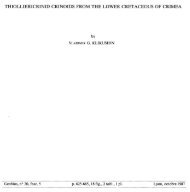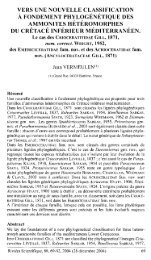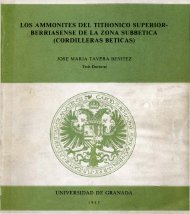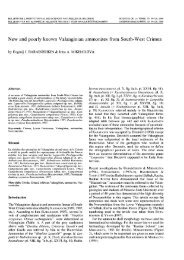peter franklin rawson, dennis curry, frank charles dilley, john michael ...
peter franklin rawson, dennis curry, frank charles dilley, john michael ...
peter franklin rawson, dennis curry, frank charles dilley, john michael ...
You also want an ePaper? Increase the reach of your titles
YUMPU automatically turns print PDFs into web optimized ePapers that Google loves.
6. CORRELATION OF THE LOWER CRETACEOUS(FIG. 3, COLUMNS 3-12)Speeton, Yorkshire (Column 3)The Speeton Clay Formation is about 100 metres thick at its type locality in FileyBay but thickens inland to reach about 400 metres in the Fordon No 1 boreholeabout 4-5 km west of Speeton (Dilley, in discussion of Neale 1968). Although all sixLower Cretaceous stages are represented, there are several non-sequences and theAptian and Albian successions are particularly poorly developed. Lamplugh (1889)divided the succession into four main units, the A, B, C and D Beds (labelled fromthe top downward), each characterized by a belemnite genus. Bed E, the thinCoprolite Bed, forms the base of the Formation. Subdivisions of these units, basedon lithology and fauna (Lamplugh 1889), provide the framework for a more detailedlithological subdivision of the D Beds by Neale (1960a, 1962a), the C Beds byFletcher (1969), the B Beds by Kaye (1964) and the A Beds by Ennis (1937),Wright (1955, in Swinnerton 1936-55) and Kaye (1964). Even now the upper partof the successsion (above Lower B) is incompletely understood because of poorexposure, so that the subdivisions of the Cement Beds, Upper B and the A Beds(mid-Barremian-Albian) should be regarded with caution. The lower subdivisionsprovide an excellent framework for collecting faunas and calibrating their distributionsagainst an independent, non-faunal standard.The ammonite zones adopted here have been discussed in Section 4; ammonitesare relatively rare except in the Hauterivian (Lamplugh 1924; Rawson 1971a), sothat the zonation is somewhat less detailed than in Spath’s (1924) idealized scheme.In contrast, belemnites are relatively common throughout, and Lamplugh (1889,1924) and Swinnerton (1936-55) demonstrated their value in broad correlation.Lamplugh’s (1889) Acroteuthis Zone (D Beds) was subsequently divided into 2zones (Swinnerton 1936) and more recently into several assemblages (assemblages2-5 and 6 pars of Pinckney & Rawson 1974). The Hibolites Zone (C Beds) containsrare Acroteuthis of assemblages 6 (pars) and 7. The recognition of a thin Aulacoteuthishorizon in the Oxyteuthis Zone (B Beds) (Rawson 1972) suggests thatthis zone could be further divided. Lamplugh (1924) divided the Neohibolites Zone(A Beds) into the ewaldi Zone below and the minimus Zone above: the latter willno doubt be further refined with the application of Spaeth’s (1971) German Albianbelemnite zonation to the Speeton sequence.Neale (1960b, 1962b) described the ostracods of the D Beds with detailed speciesranges. Three faunal assemblages occur, which broadly correspond with the stagesand major lithofacies developments (Neale 1968). The lowest is unrepresented innorth Germany, where non-marine sediments were then accumulating, but the othertwo faunas compare closely with north German ones (Neale 1968). The C Bedsostracods have yet to be described in detail, but the A and B Beds forms weredescribed in a series of papers by Kaye (e.g. 1963). Neale (1973) summarizes thedistribution of all these ostracods, with full bibliography. An unpublished study by
















